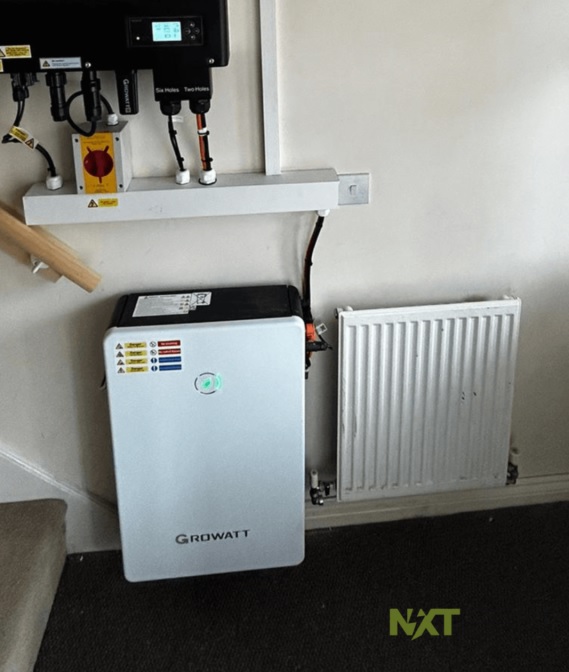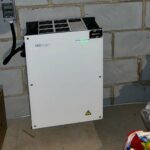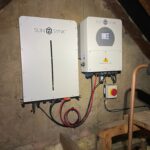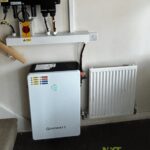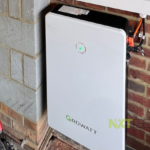With the growing popularity of solar panel systems, homeowners are increasingly looking to harness the power of the sun to reduce their electricity bills and environmental footprint. Installing solar panels is a great first step, but to maximize the benefits of your solar panel system, it’s essential to pay attention to the placement of two critical components: your solar battery storage and your solar inverter. In this blog post, I’ll explore the best places to install solar battery storage in your home to ensure optimal performance and energy savings. Then in the next post I’ll explore the best places to install a solar inverter in your home.
Temperature is a big thing for solar batteries and no matter where they are installed they are more efficient at normal room temperature. They will become less efficient at higher or lower temperatures than room temperature and they will stop working at about -10 degrees Celsius (14 degrees Fahrenheit).
Things to consider when choosing where to place your solar battery storage
When investing in a solar panel system, one of the critical decisions you’ll face is choosing where to place your solar battery storage. The placement of your solar battery can significantly impact its performance, longevity, and overall efficiency. Below I’ll explore the essential factors to consider when deciding on the best location for your solar battery storage.
Environmental Conditions
- Temperature: Extreme temperatures can affect the performance and lifespan of your battery. Choose a location with a stable and moderate temperature range. Basements, garages, and utility rooms often provide such conditions.
- Humidity: High humidity levels can be detrimental to battery components. Ensure the chosen location has proper moisture control measures in place.
Accessibility
- Ease of Maintenance: Select a location that allows for easy access to your solar battery. Routine maintenance and occasional checks are essential for optimal performance.
- Safety: Ensure that the location is safe and secure, preventing unauthorized access or tampering.
Ventilation
- Proper Airflow: Adequate ventilation is crucial to prevent overheating and maintain a stable temperature within the storage area. Consider adding fans, vents, or ducts as necessary.
Space Availability
- Size and Dimensions: Measure the available space and confirm it can accommodate your solar battery’s size and configuration. Allow room for ventilation and future expansions.
- Space Utilization: Consider whether the chosen location can be efficiently used for solar battery storage without disrupting your daily activities or the aesthetics of your home.
Proximity to Solar Panels
- Wiring Distance: Keep the distance between your solar panels and battery as short as possible to minimize energy loss during transmission. A shorter wiring distance can improve overall efficiency.
Electrical Connections
- Professional Installation: Engage a licensed electrician to ensure correct electrical connections between the solar battery, solar panels, and your home’s electrical system. Compliance with local codes and safety standards is crucial.
Aesthetics
- Visibility: Consider whether the location will be visible and its impact on the overall appearance of your property. Some homeowners prefer discreet placements to maintain a clean and uncluttered look.
Local Regulations
- Permits and Codes: Check local regulations and permitting requirements for solar battery installations. Ensure your chosen location complies with these local regulations.
Future Expansion
- Scalability: If you plan to expand your solar energy system in the future, choose a location that can accommodate additional battery storage units, without getting too hot.
Manufacturer Guidelines
- Follow Manufacturer Recommendations: Adhere to the manufacturer’s guidelines and recommendations for solar battery placement, as they are tailored to the specific model’s requirements.
Selecting the right location for your solar battery storage is a crucial decision in maximizing the benefits of your solar energy system. By considering factors such as environmental conditions, accessibility, ventilation, space availability, and local regulations, you can ensure efficient energy storage, prolong the life of your battery, and enjoy the long-term advantages of solar power for your home. Consulting with a professional solar installer like NXTGEN Energy can also provide valuable insights and guidance for your specific situation.
Solar Battery Storage Placement Locations
Solar battery storage systems are an essential addition to your solar panel system setup, allowing you to store excess energy generated during the day for use during the night or when the sun isn’t shining. Here are some considerations for the best placement of solar battery storage in your home:
Hallway
One intriguing possibility is installing a solar battery in your hallway, an often-overlooked space in many homes. Below, I’ll explore the unique advantages, considerations, and the installation process of placing a solar battery in a hallway.
Advantages of Installing a Solar Battery in Your Hallway:
- Space Utilization: Hallways are typically underutilized areas in homes, making them an excellent choice for housing a solar battery. By installing it here, you can make the most of this space while keeping it unobtrusive.
- Proximity to Electrical Systems: Hallways are usually close to the main electrical panel, simplifying the connection of the solar battery to your home’s electrical system. This proximity can reduce installation costs and streamline the entire process.
- Temperature Control: Hallways typically maintain a moderate indoor temperature, which can be ideal for a solar battery’s efficiency and longevity. This controlled environment helps ensure that the battery operates optimally.
Considerations for Installing a Solar Battery in Your Hallway:
- Space Availability: Assess the available space in your hallway to ensure it can accommodate the solar battery’s dimensions while allowing for proper ventilation and easy access. Hallways should remain clear and unobstructed for safety reasons.
- Ventilation: Proper ventilation is essential to prevent overheating of the solar battery. Consider adding fans or vents to maintain a stable temperature within the hallway.
- Safety Precautions: Ensure that the solar battery is securely fastened and protected against accidental contact or tampering, especially if you have children or pets in the household.
- Electrical Connections: Consult with a licensed electrician to ensure correct electrical connections between the solar battery, solar panels, and your home’s electrical system. Comply with local electrical codes and safety standards.
Placing a solar battery in your hallway is a creative and efficient way to utilize a typically overlooked space. With attention to space availability, ventilation, safety precautions, and electrical connections, you can successfully integrate a solar battery into your hallway, harnessing solar power while maintaining the aesthetics and functionality of your home.
Under the Stairs
One intriguing option is installing a solar battery under the stairs, a space often underutilized in many homes.
Advantages of Installing a Solar Battery Under the Stairs:
- Space Optimization: Under-stair spaces are frequently overlooked and can be efficiently used to house a solar battery, maximizing your home’s square footage.
- Aesthetically Discreet: The placement of a solar battery under the stairs is discreet and doesn’t disrupt the overall aesthetics of your home. It remains hidden from view while performing a vital function.
- Temperature Control: This location often maintains a stable indoor temperature, which is beneficial for the solar battery’s efficiency and longevity. It helps ensure consistent and optimal performance.
Considerations for Installing a Solar Battery Under the Stairs:
- Space and Accessibility: Assess the available space under the stairs to confirm that it can accommodate the solar battery and allow for proper ventilation, wiring, and easy access for maintenance.
- Ventilation: Ensure that there’s adequate ventilation in the under-stair space to prevent overheating. Consider installing fans, vents, or ducts to maintain a controlled temperature.
- Safety Precautions: Implement safety measures to protect the solar battery from accidental contact or tampering, particularly if you have children or pets.
- Electrical Connections: Consult with a licensed electrician to ensure the correct electrical connections between the solar battery, solar panels, and your home’s electrical system. Comply with local electrical codes and safety standards.
Installing a solar battery under the stairs is a creative and space-efficient approach to maximizing your home’s energy storage capabilities. With attention to space and accessibility, ventilation, safety precautions, and electrical connections, you can successfully integrate a solar battery beneath your staircase. This allows you to harness solar power efficiently while maintaining the unobtrusive appearance of your home.
Garage or Utility Room
One of the most common locations for solar battery installation is in a garage or utility room. I’ll explore the advantages of placing a solar battery in these spaces, key considerations, and how to ensure a successful installation.
Advantages of Installing a Solar Battery in Your Garage or Utility Room:
- Convenient Accessibility: Garages and utility rooms are often easily accessible, making it convenient to monitor and maintain your solar battery. This proximity simplifies routine checks and ensures prompt response to any issues.
- Temperature Control: These indoor spaces typically maintain a moderate temperature range, which is ideal for a solar battery’s efficiency and longevity. Unlike outdoor placements, where extreme temperatures can affect performance, indoor locations offer more stable conditions.
- Space Optimization: Solar batteries require a dedicated area, and placing them in a garage or utility room frees up valuable outdoor space. This is especially beneficial if your property has limited room for outdoor enclosures.
Considerations for Installing a Solar Battery in Your Garage or Utility Room:
- Ventilation: Adequate ventilation is crucial to dissipate heat generated by the solar battery. Ensure your garage or utility room has proper ventilation systems in place to prevent overheating.
- Space Availability: Evaluate the available space in your chosen location. Solar batteries come in various sizes, so choose a spot that accommodates your battery’s dimensions while allowing ample room for ventilation and easy access.
- Electrical Connections: Coordinate with a licensed electrician to ensure that the solar battery is correctly wired to your solar panels and home’s electrical system. Compliance with local building codes and safety standards is essential.
- Safety Precautions: Install the solar battery in a secure enclosure to prevent unauthorized access and protect it from damage.
Placing a solar battery in your garage or utility room is a practical and space-efficient choice that offers convenience, temperature control, and optimization of indoor space. By addressing ventilation, space availability, and safety measures, you can successfully integrate a solar battery into your solar panel system, allowing you to harness solar power effectively while enjoying the benefits of an indoor installation.
Basement
One intriguing option is to install a solar battery in your basement. This unique location offers advantages such as a controlled environment and efficient use of available space.
Advantages of Installing a Solar Battery in Your Basement:
- Temperature Control: Basements typically maintain a stable and moderate temperature year-round, making them an ideal location for a solar battery. Unlike outdoor placements where extreme temperatures can affect battery performance, basements provide a climate-controlled environment that can extend the life of your battery.
- Space Utilization: Basements often offer ample space that might otherwise go unused. Installing a solar battery in your basement allows you to make the most of this area while keeping it out of sight.
- Protection from Environmental Elements: Your basement provides protection from the elements, reducing the risk of weather-related damage to your solar battery.
Considerations for Installing a Solar Battery in Your Basement:
- Ventilation: Ensure that your basement has adequate ventilation to prevent heat build-up. Proper ventilation helps maintain the optimal temperature range for your solar battery.
- Accessibility: Consider how you will transport and install the solar battery in the basement. Ensure there’s enough space and accessibility for installation and any future maintenance requirements.
- Electrical Connections: Consult with a licensed electrician to ensure that the solar battery is correctly integrated into your solar panel system and connected to your home’s electrical system. Compliance with local electrical codes and safety standards is essential.
Placing a solar battery in your basement can be a practical and space-efficient choice for homeowners looking to optimise their solar panel system. With attention to ventilation, accessibility, and electrical connections, you can successfully integrate a solar battery into your basement, taking advantage of the stable temperature and protection from environmental elements. This ensures efficient solar power utilization while making the most of your basement space.
Loft
While many homeowners place their solar batteries in hallways, garages, or utility rooms, another viable option is installing a solar battery in your loft space.
Advantages of Installing a Solar Battery in Your Loft:
- Space Utilization: Lofts are often underutilized spaces in many homes. Installing a solar battery in your loft allows you to make the most of this space, which might otherwise be used for storage or remain empty and also everything is out of the way.
- Temperature Control: In many regions, loft spaces tend to be cooler than outdoor temperatures during the summer and warmer during the winter. This more moderate temperature range can help improve the efficiency and lifespan of your solar battery. Solar batteries are more efficient at room temperature, as they will stop working at -10 degrees.
- Reduced Footprint: Loft installations free up valuable floor space in your garage or utility room, which can be used for other purposes or for additional storage.
Considerations for Installing a Solar Battery in Your Loft:
- Ventilation: Adequate ventilation in your loft is essential. High temperatures can reduce the efficiency and lifespan of a solar battery. Ensure that your loft has proper ventilation to maintain a moderate temperature.
- Weight Capacity: Before installing a solar battery in your loft, consult with a structural engineer or contractor to ensure that your loft’s floor can support the additional weight. Batteries can be heavy, and overloading the loft floor can lead to structural issues.
- Accessibility: Consider how accessible your loft is for installation and future maintenance. You’ll need a way to transport the battery into the loft, and there should be enough space to manoeuvre and access the battery easily.
- Environmental Conditions: Assess the environmental conditions of your region. Extreme humidity or temperature fluctuations may not be suitable for a solar battery in the loft. In such cases, you might need to implement additional insulation and climate control measures.
- MCS Regulations: New MCS regulations specify a synced fire alarm must be installed to comply with MCS certification if solar batteries are installed in the loft, mainly due to this being an area unattended for safety precautions.
Installing a solar battery in your loft can be a space-efficient and energy-efficient choice for many homeowners. However, it requires careful planning, structural assessment, and consideration of environmental factors. By working with experienced professionals like NXTGEN Energy and taking these factors into account, you can successfully harness solar power and optimize your home’s energy consumption from your loft space.
Outdoor Enclosures
As homeowners increasingly turn to solar energy systems to reduce their environmental footprint and electricity costs, the placement of key components becomes crucial. For some, installing a solar battery in an outdoor enclosure is a practical choice. This setup offers its unique benefits, including space optimization and direct exposure to sunlight for the solar panels.
Advantages of Installing a Solar Battery in an Outdoor Enclosure:
- Space Optimization: Outdoor enclosures free up valuable indoor space, making them an attractive option for homeowners with limited room in their garage or utility room.
- Direct Sunlight Exposure: Placing the solar battery outdoors ensures that it is directly exposed to sunlight, which can be advantageous for powering the battery’s charging system. This exposure can lead to increased efficiency and faster charging.
- Aesthetics: Solar batteries in outdoor enclosures are often more discreet and can blend seamlessly with your property’s exterior, maintaining a neat and visually appealing appearance.
Considerations for Installing a Solar Battery in an Outdoor Enclosure:
- Weather Resistance: Ensure that the enclosure is designed to withstand harsh weather conditions, including rain, snow, and extreme temperatures. Proper weatherproofing is essential to protect the battery and its components (IP65).
- Security: Take security precautions to protect the solar battery and enclosure from theft or vandalism. Some enclosures come with lockable features for added security.
- Ventilation: Adequate ventilation is crucial to prevent heat build-up within the enclosure, which can impact battery performance and longevity. Consider fans or vents for improved airflow.
- Electrical Connections: Consult with a licensed electrician to ensure correct electrical connections between the solar battery, solar panels, and your home’s electrical system. Compliance with local electrical codes and safety standards is paramount.
Placing a solar battery in an outdoor enclosure can be a practical choice, offering advantages such as space optimization and direct sunlight exposure. However, careful consideration of weather resistance, security, ventilation, and electrical connections is essential for a successful installation. With proper planning and installation, you can efficiently harness solar power while maintaining an aesthetically pleasing and secure outdoor setup.
Conclusion
Proper placement of solar battery storage plays a vital role in the overall performance and longevity of your solar panel system. By choosing the right locations and taking steps to protect these components from harsh environmental conditions, you can maximize the benefits of your solar panels, save on electricity bills, and reduce your carbon footprint. Consult with a professional solar installer like NXTGEN Energy to ensure your solar PV system is installed in the most optimal way for your specific home and needs.
If you are a UK homeowner who wants to learn more about the best location to put your solar battery storage, you can contact our experienced solar energy team today on 01268 928 690 or info@nxtgen.ltd, or click on the ‘Enquire Now’ button below. They will be happy to answer your questions and provide you with free advice on the best location for solar battery storage.
Frequently Asked Questions about Battery Storage System Locations
Since exposure to direct sunlight can cause overheating of the components, it can reduce the battery efficiency. So, choose a shaded spot away from direct sunlight. Not only it enhances battery efficiency, but it also promotes lifespan.
The ideal place for a solar battery storage system to be installed is in the house, close to the consumer unit. Example locations are a hall cupboard, an understairs cupboard, the utility room and so on. If, however, this option isn’t available then there are two main alternatives: Garage or loft.
Solar batteries work best at room temperature so they should be installed indoors. For most people, this means batteries are often in the cupboard under the stairs or a utility room. Alternatively, if it’s not possible or practical to have the battery indoors, you can install it in the loft or in your garage.
Home solar batteries can be installed either indoors (i.e. a separated area, like a garage for example, to which there’s no habitable area on the other side of the wall) and outdoors.
Solar batteries are usually found mounted to walls but they can also be floor mounted, this provides ample opportunity to find a suitable location to install inside or outside the home.
It is perfectly fine to place a solar battery directly on concrete. That’s because today’s battery cases are made of tough plastics such as polycarbonate or polypropylene for greater impact resistance. These plastics are strong and don’t degrade the way hard rubber can.
Latest Solar Battery Storage Posts
- Duracell Dura5: A Safe and Scalable Home Battery SolutionThe Duracell Dura5 Battery is shaking up the residential energy storage scene with its commitment to safety, performance, and adaptability. This Lithium Iron Phosphate (LiFePO4) battery system packs a punch with a 5.12kWh capacity (4.6kWh usable) and a reassuring 10-year warranty, ensuring long-lasting peace of mind for consumers. Safety First: The Power of LiFePO4 Chemistry… Read more: Duracell Dura5: A Safe and Scalable Home Battery Solution
- The Value Proposition of Battery Storage for Solar Panel SystemsIs your solar energy investment reaching its full potential? While solar panels gleaming on rooftops capture the sun’s rays, maximizing the utilization of that harnessed solar power is crucial for reaping the true rewards of clean energy. Solar battery storage holds the key, transforming your home or business into a self-sufficient energy hub. This post… Read more: The Value Proposition of Battery Storage for Solar Panel Systems
- SunSynk Batteries: Innovative Energy StorageSunSynk Batteries have emerged as a leading solution in the realm of energy storage, offering a range of innovative features and benefits that cater to various applications. With a focus on sustainability and cutting-edge technology, SunSynk Batteries have captured the attention of residential, commercial, and industrial consumers alike. This blog post delves into the intricate… Read more: SunSynk Batteries: Innovative Energy Storage
- Solar Industry Update: Battery Installations in LoftsThe British Standards Institute (BSI) has recently released new recommendations regarding home battery installations, including those in loft spaces. One common inquiry we receive from our customers following the publication of the Publicly Available Specification (PAS) is whether a solar battery can be installed in a loft. The answer is a resounding yes, with some… Read more: Solar Industry Update: Battery Installations in Lofts
- Who are NXTGEN Energy Ltd?NXTGEN Energy Ltd are a solar energy company based in Rayleigh, Essex, UK. They specialize in the installation of solar panels, battery storage systems, and electric vehicle chargers for homes and businesses across the UK. They are MCS certified, which means they meet the Microgeneration Certification Scheme’s standards for quality and safety. This makes them… Read more: Who are NXTGEN Energy Ltd?
- Quick Guide to Solar Batteries and StorageThe Sun: Our Brightest Battery The world of renewable energy is a constantly evolving landscape, and solar power has emerged as a clear leader in the race towards sustainability. As the demand for clean and efficient energy solutions soars, so does the importance of understanding the key components that make solar installations truly effective. One… Read more: Quick Guide to Solar Batteries and Storage
- Solar Panel FinancingAt NXTGEN, we are committed to delivering excellent service and we understand that many customers may prefer the option of paying for their solar panels with finance. So, we’ve partnered with established credit brokers, Ideal4Finance, to enable customers to spread the cost of purchase with manageable monthly payments. We can offer 3 Flexible Finance Options… Read more: Solar Panel Financing
- Q4 2023 Marks Record Increase in Battery Energy Storage CapacityIn a significant development for the renewable energy sector, the end of 2023 witnessed the largest quarterly surge in battery energy storage. According to Modo Energy (https://modoenergy.com), a renowned energy research consultancy, a staggering 420MW of new battery energy storage capacity became commercially operational during this period. This remarkable achievement represents a remarkable 13% increase… Read more: Q4 2023 Marks Record Increase in Battery Energy Storage Capacity
- No More VAT On Solar Battery StorageUK Government announces 0% VAT on Solar Battery Storage Systems In a momentous announcement made in December 2023, the UK government has revealed substantial reforms to the current VAT relief on the installation of qualifying energy-saving measures. This development is cause for celebration among energy enthusiasts like us! Expanding on Chancellor Rishi Sunak’s previous announcement… Read more: No More VAT On Solar Battery Storage
- Growatt BatteriesGrowatt Batteries: A Smart Choice for Home Energy Storage If you are looking for a reliable, safe, and long-lasting battery solution for your home solar system, you might want to consider Growatt Batteries. Growatt is a leading manufacturer of solar inverters and battery storage systems, with over 10 years of experience and a global presence.… Read more: Growatt Batteries

